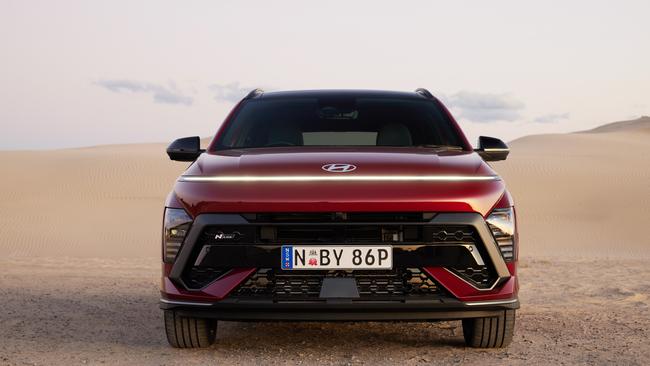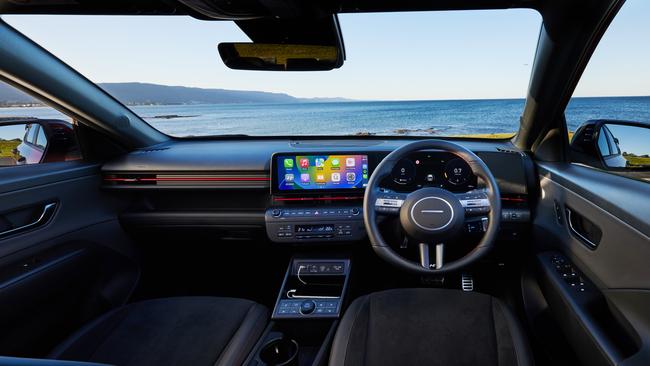Hyundai Kona review: there’s a model for everyone
The budget-friendly Korean brand might just be making the best-looking cars on the road at the moment.

You’ve got to feel for carmakers in times like these.
Well, as much as you can feel for gigantic multi-billion-dollar companies that currently can’t make enough vehicles to keep up with the cashed-up demand in Australia.
Still, there was once a time when launching a small SUV here was a pretty straightforward business. You’d plonk in a small petrol engine, and that would be that.
But no more. Now you have to take a Baskin-Robbins-style approach, needing all 31 flavours to appeal to an increasingly fragmented customer base. Fast ones, slow ones, efficient ones, electric ones, and so on.
Take the all-new Hyundai Kona, for example. You can have it with one of two petrol engines, and with sporty or less sporty styling, and then there will be a hybrid one, and finally an all-electric model before the end of the year. That’s four powertrain options, several gearboxes and a whole lot of expensive engineering to pour into one small SUV.
It forms a part of Hyundai’s staggered electrification push, with the auto giant suggesting that not everyone is ready to make the full EV switch — or any switch at all — so variety remains the key to big sales.

“When we think about Kona, we can’t help but think about the representation of what Hyundai will look like going forward. It has three powertrains, it has an ICE powertrain, a hybrid powertrain and it has an EV powertrain,” Hyundai Australia’s Chief Operating Officer John Kett told us.
“It starts to give you a sense of what we think in terms of accessibility to mobility in every segment. Our dream is that everyone walks with us to zero emissions. But let us let you enter the electrification process with a hybrid.”
So far, we’ve driven the two petrol engines — one a 2.0-litre four-cylinder petrol producing 110kW and 180Nm, which powers the front wheels, and is paired with a CVT automatic, and the other a 1.6-litre turbo petrol engine producing 142kW and 264Nm, which gets a proper eight-speed automatic and all-wheel drive.
The range now kicks off from $32,000 for the cheaper engine (up around $5k on the model this new one replaces) and $40,000 for the faster AWD version. That is on the pricey side, but the Kona justifies some of that by simply looking expensive.
You can forget those premium German cars or anything from Japan, because I reckon the (sort of) budget-friendly Korean brand might just be making the best-looking cars on the road at the moment.
I mean, just look at this new Kona. I mean really, look at it. Unusually, this model was designed as an electric vehicle first, with that blueprint then feeding the petrol-powered models. And the result is a small SUV that looks premium, future-facing and undeniably funky, from the thin light strip that spans the width of its bonnet and rump, to the body creases that look so sharp it’s like they’ve been designed with a hammer and chisel.
Inside, it’s modern-feeling (if a little button-heavy), too. This car is bigger and thus more spacious than the model it replaces, but it’s also swimming with easy-to-use tech, including a big 12.3-inch touchscreen that runs your Apple CarPlay or Android Auto.
On the road, the petrol-powered Kona feels a little less futuristic, but no less satisfying. For mine, the cheapest petrol engine is more than enough in a car this size, generating enough grunt to get the Kona up and moving, and with a CVT — sometimes a droning, dulling annoyance — that does a commendable job of pretending it’s a regular automatic, particularly via the artificial “steps” built in to mimic the gears you’d normally step through with a torque converter or dual-clutch gearbox.
The ride is generally great, owing to Hyundai Australia dipping into the global parts bin and picking the bits that work best for our conditions rather than actually tuning the car here, and it even feels sorted and a little sporty should you wander onto a twisting road.
Yes, the 1.6-litre turbo option will give you more power, and a slightly better ride, but it also drinks more fuel (7.6 vs 6.6L/100km), and — thanks to its N-Line styling — commits the common crime of looking more aggressive than it actually is.
The incoming hybrid, though, might just be worth waiting for. It pairs a 1.6-litre petrol engine with an e-motor and a 1.32kWh battery, which, combined, delivers 104kW and 265Nm, all while sipping just 3.9L/100km.
That’s turbo-rivalling torque with properly miserly fuel use, the latter better than even those hybrid masters over at Toyota can manage with the Corolla Cross Hybrid.
Actually, maybe we can forget the whole Baskin-Robbins thing. It sounds like one electrified flavour might be all we need after all.


